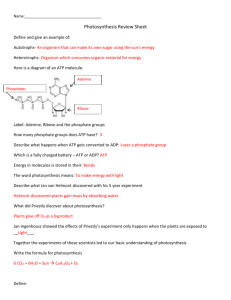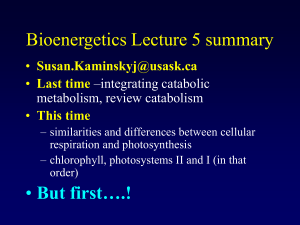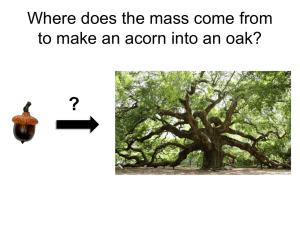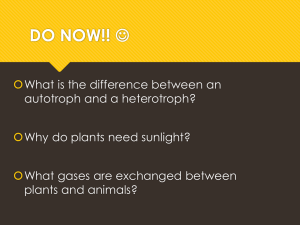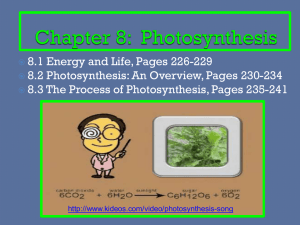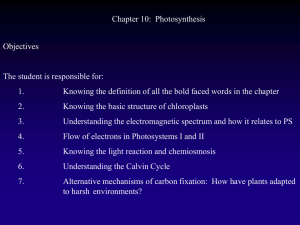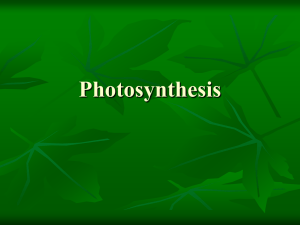CH-8 Photosynthesis - Newark City Schools
advertisement
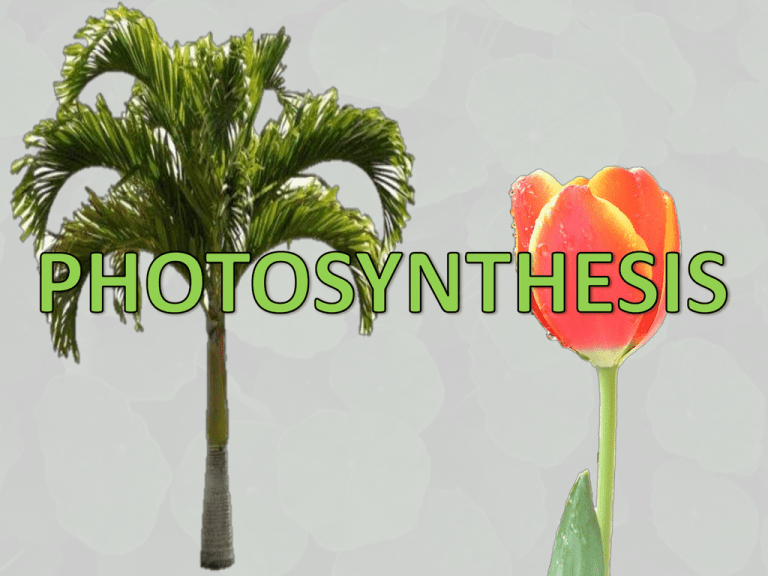
How do organisms get energy? • Autotrophs and Heterotrophs –Autotrophs – organisms that can capture energy from sunlight or chemicals and use it to produce its own food. How do organisms get energy? • Autotrophs and Heterotrophs –Heterotrophs – organism that obtains energy from the foods it consumes Chemical Energy and ATP ATP (adenosine triphosphate) = The principal chemical compound that living things use to store energy o ATP = 3 Phosphate groups ADP (adenosine diphosphate) has a very similar structure to ATP, but with only two phosphate groups. o ADP = 2 Phosphate groups Chemical Energy and ATP • The energy stored in ATP is released when ATP is converted to ADP. The breaking of the bond between the second and third phosphate group releases this energy. Chemical Energy and ATP ATP ADP Fully charged battery Partially charged battery Investigating Photosynthesis • When a tiny seedling grown into a tall tree with a mass of several tons, where does the tree’s increase in mass come from? From soil? From water? From air? Investigating Photosynthesis Van Helmont – 1600s o Wanted to know if plants grew by taking material out of the soil. o Weighed a pot of dry soil and a small seedling. He watered it regularly and at the end of five years the seedling had gained 75 kg. The mass of the soil was exactly the same. o Helmont concluded that the mass gain came from water o HE WAS WRONG Investigating Photosynthesis Priestly – 1700s oPut a candle under a bell jar, the fire went out. Added a small plant and the fire continued to burn for a few days. Through the work of all these scientists it was discovered that….. • In the presence of light, plants transform carbon dioxide and water into carbohydrates and release oxygen Investigating Photosynthesis Ingenhousz o Showed that Priestly’s results were only valid if the plant was exposed to light. Photosynthesis 6CO2 + 12H2O + light → C6H12O6 + 6O2 Photosynthesis uses the energy of sunlight to convert water and carbon dioxide into oxygen and high-energy sugars Light and Pigments Plants gather the sun’s energy with lightabsorbing molecules called pigments. The plant’s principal pigment is chlorophyll Inside a Chloroplast Photosynthesis takes place inside the chloroplast oChloroplasts contain saclike membranes called thylakoids (looks like a pancake) oA stack of thylakoids is known as grana (looks like a stack of pancakes) oThe area outside of the grana, but inside the chloroplast is known as stroma (kind of like the syrup on the pancakes) Inside a Chloroplast The Chemical Reactions of Photosynthesis • NADPH Like ATP, the molecule NADPH can also store energy. o NADP+ + Energy NADPH o So when an organism breaks down NADPH energy it gets NADP+ and energy NADPH NADP+ Fully charged battery Partially charged battery The Chemical Reactions of Photosynthesis • Light-Dependent Reactions REQUIRE LIGHT Light-dependent reactions produce oxygen gas and convert ADP and NADP+ into the energy carriers ATP and NADPH Harvests the sun’s energy and charges the battery The Chemical Reactions of Photosynthesis • Calvin Cycle Because the Calvin Cycle does not require light, it is also called light-independent reactions The Calvin cycle uses ATP and NADPH form the light-dependent reactions to produce sugar Uses the energy stored in the light-dependent reactions to create food. Factors Affecting Photosynthesis Weather oAmount of rain oTemperature oIntensity of light
